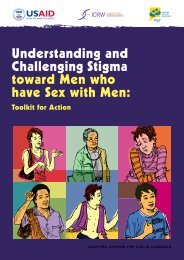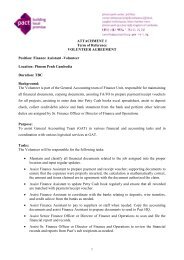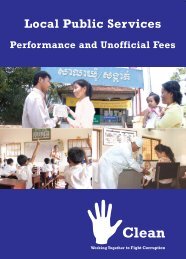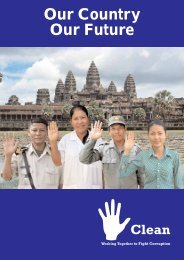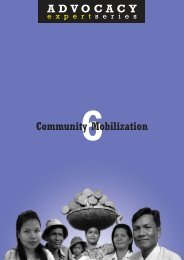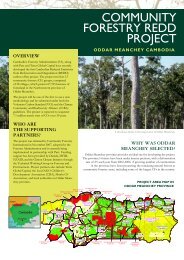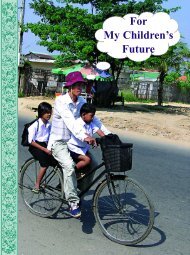Advocacy in Cambodia: Increasing Democratic ... - Pact Cambodia
Advocacy in Cambodia: Increasing Democratic ... - Pact Cambodia
Advocacy in Cambodia: Increasing Democratic ... - Pact Cambodia
Create successful ePaper yourself
Turn your PDF publications into a flip-book with our unique Google optimized e-Paper software.
communities protest land grabb<strong>in</strong>g <strong>in</strong> front of the<br />
National Assembly, when garment factory<br />
workers hold strikes, and when commercial sex<br />
workers march on the M<strong>in</strong>istry of Women’s<br />
Affairs. The strategy may also <strong>in</strong>clude large-scale<br />
education or awareness-rais<strong>in</strong>g activities to ensure<br />
that affected communities have a clear<br />
understand<strong>in</strong>g of the issues and the options<br />
available to them. An example of this strategy<br />
would be a commemorative activity such as<br />
International Human Rights Day.<br />
<strong>Advocacy</strong> campaigns will use different<br />
strategies depend<strong>in</strong>g on whether the advocates are<br />
members of the community, <strong>in</strong>fluential people,<br />
government officials, and/or <strong>in</strong>stitutions like<br />
multilateral banks. Community-based campaigns<br />
depend on the power generated through solidarity<br />
and thus require <strong>in</strong>tensive organiz<strong>in</strong>g, while<br />
advocacy by <strong>in</strong>fluential <strong>in</strong>stitutions is conducted<br />
along more official l<strong>in</strong>es. Solidarity between<br />
<strong>in</strong>stitutions can make an advocacy campaign<br />
stronger.<br />
In a country like <strong>Cambodia</strong> where the<br />
evolution of legislation is now part of the political<br />
process, advocacy will be directed at lawmakers.<br />
However, advocacy is by no means limited to<br />
<strong>in</strong>fluenc<strong>in</strong>g government. In the past two decades,<br />
NGOs around the world have begun to <strong>in</strong>fluence<br />
the multilateral banks on a number of policies.<br />
Companies and large corporations are also a<br />
common target. In <strong>Cambodia</strong>, garment factories<br />
have been the ma<strong>in</strong> target of labor unions because<br />
the factories have shown a disregard for the basic<br />
rights of workers. Because the M<strong>in</strong>istry of Labor<br />
has been slow to enforce the labor code with<br />
companies, the unions are also focus<strong>in</strong>g their<br />
advocacy efforts on the government while try<strong>in</strong>g<br />
to limit company violations.<br />
Footnote<br />
1<br />
This report uses this def<strong>in</strong>ition, although it is understood that<br />
advocacy can be organized to benefit a cause, such as promot<strong>in</strong>g the<br />
arts, protect<strong>in</strong>g the environment, or sav<strong>in</strong>g animals from ext<strong>in</strong>ction.<br />
advocacy <strong>in</strong> the<br />
cambodian context<br />
6Increas<strong>in</strong>g <strong>Democratic</strong> Space<br />
Growth of <strong>Cambodia</strong>n Civil Society and<br />
How It Affects <strong>Advocacy</strong><br />
Civil society is generally understood to<br />
<strong>in</strong>clude all associations and <strong>in</strong>teractions that exist<br />
outside of the government and market sectors.<br />
Civil society organizations (CSOs) were first<br />
allowed to register <strong>in</strong> <strong>Cambodia</strong> <strong>in</strong> 1992 dur<strong>in</strong>g<br />
the U.N. Transitional Authority <strong>in</strong> <strong>Cambodia</strong><br />
adm<strong>in</strong>istration (UNTAC). The ma<strong>in</strong> manifestation<br />
of civil society <strong>in</strong> <strong>Cambodia</strong> has been nongovernment<br />
organizations (NGOs). Other types of<br />
organizations <strong>in</strong>clude labor unions, communitybased<br />
organizations (CBOs), professional<br />
associations, and student groups. Less common<br />
types <strong>in</strong>clude religious organizations, sport<br />
associations, and youth clubs.<br />
As of November 2001, 867 local<br />
organizations and associations were registered<br />
with the M<strong>in</strong>istry of Interior’s NGO Department.<br />
There are no reliable statistics on how many of<br />
these associations are currently <strong>in</strong> operation, but<br />
estimates put the actual figure at between 200 and<br />
400. Accord<strong>in</strong>g to the Cooperation Committee for<br />
<strong>Cambodia</strong> (CCC), there are 250 <strong>in</strong>ternational<br />
agencies work<strong>in</strong>g <strong>in</strong> the country. All CSOs are nonprofit<br />
organizations and the two ma<strong>in</strong> types of<br />
structures are associations and NGOs.<br />
Associations<br />
When <strong>in</strong>dividuals or groups identify common<br />
<strong>in</strong>terests they set up associations to further those<br />
<strong>in</strong>terests. The most common structure of an<br />
association is a large membership group that elects<br />
a voluntary management committee. If necessary,<br />
the committee can hire staff. A prov<strong>in</strong>cial rice<br />
millers association is an example of a group of<br />
people who work <strong>in</strong> the same <strong>in</strong>dustry. They come<br />
together as an association to exchange<br />
<strong>in</strong>formation, <strong>in</strong>crease their technical skills, and<br />
look for ways to improve the standards of the rice<br />
<strong>in</strong>dustry, such as better quality of seed or higher<br />
quality of milled rice. Although the <strong>in</strong>dividual<br />
bus<strong>in</strong>esses compris<strong>in</strong>g the association are forprofit<br />
entities, the association itself is a non-profit<br />
organization.<br />
Many of the groups that are called<br />
associations, such as student associations, are <strong>in</strong><br />
effect managed like local NGOs because <strong>in</strong> these<br />
associations the membership does not determ<strong>in</strong>e<br />
the direction of the programs. Often they will not<br />
have a function<strong>in</strong>g board. For this reason, only




